PinotFile: 6.38 September 2, 2007
|
Calera: Pinot Grows Where Limestone FlowsWith its 2005 vintage wines, some of which have been released, Calera Wine Company is celebrating its 30th vintage. In 1975, when Josh Jensen first planted his vines on a remote property in the Gavilan Mountains, he was among a select few pioneers at the time who were attempting to farm Pinot Noir in California. Dick Graff had preceded Jensen by ten years at Chalone, located just north of Calera in the same Gavilan Mountain Range in San Benito County. Others included Richard Sanford in Santa Barbara County (Sanford & Benedict Vineyard), David Bruce and Merry Edwards (Mt Eden) both in the Santa Cruz Mountains, Joseph Swan, Bob Pellegrini (Olivet Lane) and Joe Rochioli, all in the Russian River Valley, Tony Husch in the Anderson Valley, and Francis Mahoney (Carneros Creek) in Carneros. As it would turn out, despite the diversity of microclimates each grower settled on, all of them proved quite successful. There was only one innovator (other than Graff at Chalone - see * note at end on page 6), however, who based his whole success on limestone which was rarely found in California soil in areas appropriate for viticulture. A student and fervent lover of Burgundy, Jensen was convinced that it was the limestone in the soil in Burgundy that made the wines so special. Jensen has said, “Here in this country, the establishment doesn’t think limestone is important. I didn’t waste my time debating it. I just saw where the great Burgundies grow and decided to let my wines do the talking.” 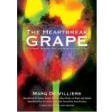 Josh Jensen’s remarkable story was first told in detail in 1993 in the first edition of the book, The Heartbreak Grape, A Journey in Search of the Perfect Pinot Noir, by Marq de Villiers. A completely revised and updated version was published in 2006 (McArthur & Company, paperback, $10.99) and is the source for much of the information to follow in this feature article. A lot has changed since Jensen released his first Calera Pinot Noir in 1978. As Tim Patterson remarked last year, “Pinot Noir is no longer the heartbreak grape. But it does still have a mind of its own.” Jensen’s saga is an inspiration for anyone hoping to follow a passion for Pinot Noir and only now, after thirty-two years has his heartbreaking efforts found vindication. Pinot Noirs from California, and in particular those from Calera, can hold their own to the best from Burgundy. Josh Jensen’s father was a dentist, and it was another dentist friend, Dr George Selleck, a prominent wine enthusiast, who first introduced Josh to wine. After college at Yale, Jensen attended Oxford, where he obtained a degree in anthropology, A very unlikely precursor to a life committed to winemaking, but Jensen drank wine daily at Oxford and acquired a special love for Burgundy. He also had some ability to speak French, and in the summer of 1969 traveled to Domaine Romanee-Conti and applied for a job as a picker. The next year he was hired by André Noblet, who was in charge of the Domaine. The following year he worked the harvest at Domaine Dujac, where he struck up a close friendship with Jacques Seysses. When he returned to California in 1973, he was focused on producing fine Pinot Noir. It was a gamble, for sure, and he was the first to admit it in later years. “In my case, I just gambled. Pinot Noir was immensely unfashionable when I started. I was young enough that I didn’t realize I couldn’t do it, so I just did it. I was too dumb to realize I couldn’t.” 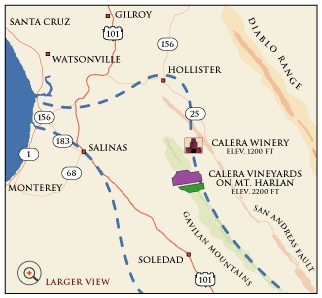 For two years, he searched California for a site that combined limestone soils and a suitable climate for growing Pinot Noir. In 1974, he purchased 324 acres at 2,300 feet elevation in the Gavilan Mountains for $18,500. The land was originally owned by the S.H. Powell Co. mining operation which had at one time quarried large amounts of limestone there. This was about as unlikely a spot to grow Pinot Noir as one could find. It was extremely isolated, with no paved roads. Jensen actually owned no land that provided access to the property until 1982 when he purchased an adjacent property which also had limestone and a water supply. Most of the property consisted of steep hillsides, there was no electrical power and no telephone lines. It was located on what the United States Geographical Survey termed ’the central creeping zone’ of the San Andreas Fault. The remote area was alive with rattlesnakes, rabbits, gophers, deer, wild pigs and squirrels. What it did have, however, was a suitable climate for growing Pinot Noir. Fog rolled in frequently from the neighboring valleys creating warm days and cool nights. The potential for very long growing seasons was the result and, in fact, Calera often harvests well into October, after both Carneros and Sonoma. The soil was poor in nutrients, but it did have plenty of limestone.
With the cash infusion from his partners, his father and William Garrard Reed (a successful businessman), he set out to build a winery out of an old rock crushing plant on the property and establish vineyards on the hillsides further up the mountain. Jensen chose the name Calera, which is Spanish for lime kiln, referencing the old lime kiln left on the land when he acquired it. He moved onto the property with his wife and two children and lived there in a 10 ft by 60 ft mobile home for over four years. In 1975, he cleared enough land to plant the initial three Pinot Noir vineyards, located approximately a 50-minute drive from the winery site. The vineyards were Jensen (named after his father, Stephen), Selleck (named after Dr George Selleck who first introduced him to wine), and Reed (after his initial business partner). Mills (named after John Everett Mills who built the infrastructure on the property on Cienaga Road for a mining operation - these retaining walls were to become part of Calera’s gravity-flow winery), and the Chardonnay and Viognier plantings followed in 1984. The Jensen Vineyard is nearly 14 acres, Reed is 4.4 acres, Selleck is 4.8 acres, and Mills is 14.4 acres. The most recent Pinot Noir planting is the Ryan Vineyard (named for Jim Ryan, the vineyard manager since Calera began) which is 13.1 acres and was planted in 1998 and 2001. Currently, there are some unnamed plantings of Pinot Noir which has not produced commercially-viable grapes as yet. Jensen feels that that are probably locations on his property that may have an even better potential for Pinot Noir than his original plantings. 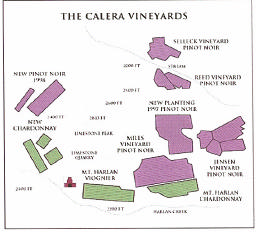 The planting of the initial vineyards was a struggle. Water had to be crated uphill for irrigation. Battling gophers and other animals was a full-time job. Mildew, leaf roll virus, leafhoppers, and oak root fungus were constant threats.
It is not clear (Jensen isn’t saying) where exactly the original clones of Pinot Noir at Calera came from. Selleck, Reed and two-thirds of Jensen are probably “suitcase clones” either directly from Domaine Romanee-Conti or indirectly from Chalone. The rest of the plantings are presumably from nursery bench grafts originating in California. The Mills Vineyard, Chardonnay and second planting of Viognier are own-rooted, the rest of the plantings are grafted onto nursery rootstock. By 2006, Jensen had 83.6 acres planted on his property which consisted of 648 acres (the first two parcels purchased in 1974 and 1977) and 440 adjacent acres. The winery, the world’s first and only completely gravity-flow winery, was built into a hillside on seven different levels. The first vintage of estate Pinot Noir was in 1978, all of 700 cases in half-bottles, and was the initial Calera wine made at the winery. Calera is the only winery in the Mt. Harlan AVA (he can also use the Central Coast AVA and San Benito AVA designations as well). Curiously though, the vineyards are in the Mt Harlan AVA, but the winery technically is not, so he cannot use “estate bottled” on the label. Jensen has certainly had his struggles. Yields have been painfully low, with averages of about 1½ tons per acre, with a number of vintages providing less than a ton per acre. Pinot Noir is notoriously difficult to grow and Jensen was painfully aware of this. “We had vineyards producing a variety that was considered impossible to do well in California then. We had people, even family and friends, saying I’d lose my shirt and make a fool of myself over this.” He had to make zinfandel from acquired grapes until 1985 to provide some cash flow. Fortunately, he retained control of his vineyards from the beginning (only recently has he given parcels to his children) and assumed complete ownership of his winery several years after his beginnings. His sold his first vintage, 1978, for $18.50 a half-bottle. By 1999, he had received many favorable reviews for his wines and the Calera Pinot Noirs were priced at $80 a bottle. Despite this, the popularity of Calera seemed to languish in the following years with the wine press and public turning their attention to newer and more fashionable cult producers. Sales suffered and he was forced to drop his price range for Pinot Noir to $42 to $50 a bottle where it has remained to the present time. The Calera Pinot Noirs are probably the closest to the Burgundian idiom of all Pinot Noirs in California. The wines are shy and reticent upon release, with the best drinking window between 5 and 20 years after the vintage. Jensen abhors what he calls “Smasher-Blasters,” California Pinot Noir fruit bombs that “are mostly one-dimensional, simple but potent beverages that will merely lose their fruit, their main if not their only appeal, with the passing years and just turn into …. expensive mud.” His vision for the perfect Pinot Noir is well reflected in the eloquent style of his wines and is one “that is perfectly balanced on the cusp of richness and complexity, of fruitiness and subtlety, and is neither one nor the other.”  The first winemaker at Calera was Steve Doerner, a microbiologist who had never made wine. He worked closely with Jensen until 1992 when he left for Cristom Estate in the Willamette Valley of Oregon. Through the years, many future stars of the California winemaking industry spent time at Calera learning from Mr Pinot (Josh’s moniker).
Calera’s winemaking regimen is as follows. The grapes since 1984 have not been de-stemmed (except for some purchased grapes and grapes from young vines). No cold soak is employed. Typically, tartaric acid is added, native yeasts are utilized for fermentation, punch downs are by hand, and the wines undergo 100% malolactic fermentation in Francois Freres oak barrels. New oak is typically 30%. Racking is done twice into the fining tank (egg whites are used) and bottling tank. The single-vineyard Pinot Noirs are aged for 18 months prior to bottling. Interestingly enough, the wines of Calera are widely distributed in the United States and universally acknowledged as benchmarks for California Pinot Noir, yet Japan has the most avid fans for Calera wines and where Calera has a cult following. A few years ago, a Japanese adult comic book or ‘manga’ featured a crime-fighting sommelier. In one episode, the hero is given a couple of wines to taste and concluded the wine must be Domaine Romanee-Conti, only to recall at the last second that it could also be Calera’s Jensen Vineyard Pinot Noir since it is the only other wine of similar character and quality in the world. Robert Parker has been one of the most outspoken fans of Calera Pinot Noir. In 2003, Parker tasted 64 Calera Pinot Noirs dating back to 1987 (eRobertParker.com, April, 2003). “Calera is one of the most compelling Pinot Noir specialists, of not only the New World, but of Planet Earth. Credit must be extended to its visionary founder, proprietor Josh Jensen. Ironically, today Jensen rarely gets the acclaim that these wines merit.” Noted wine critic and author, Oz Clarke, wrote in The New Classic Wines about the typicality of each of the single vineyard Calera Pinot Noirs. “Jensen is the most open, with deliciously accessible flavors of strawberry and honey, sometimes developing an almost candied sweetness which ages to a thrilling combination of raspberry sauce richness, swished with the rasping perfume of leather. Reed has a less dense style - combining the savory perfumes of roast coffee and earth with a fruit of blackberry and the herbal aromas of sassafras. Selleck is denser in every way. More tannic, slower to evolve, but magnificently perfumed, full of the classic Burgundian entangled mysteries of cherry and plum, wild raspberry, toast and cinnamon spice. Mills exhibits that rarest and most haunting of perfumes - that of violets.” Josh Jensen’s comments are, of course, most valuable. “Jensen is a complex wine and for me consistency of complexity is really the ultimate compliment to a Pinot Noir. Jensen is usually the most tannic and also the leanest, the least rounded. It has some type of olive character, a spiciness, and … .well, the well runs dry after saying those things. The Reed most years has to me a sort of chocolaty, raisiny character. In personality, it has acquired a softness and precociousness. We release it first of the single- vineyard wines. The Selleck is my personal favorite almost every vintage. It is also the fastest to evolve (opposite of Clarke’s remarks!). It seems to have one more layer, one more bit of depth and complexity than the others, and since that’s what I appreciate the most it appeals to me the most. The Selleck is the most feminine of our wines, the most subtle. It seems to taste of spice, nutmeg, truffles and earth together, and floral, so it is complete and complex. The Mills has terrific structure but it often seems leaner than the other three. Compared to any other Pinot Noir from any other producer it is rich, full-flavored, dark and complex. But compared to our own vineyards, it seems less rounded and supple and fat by comparison.” I recently tasted through several Calera single-vineyard Pinot Noirs as well as some white wines. I must admit that I had veered away through the years, looking at many of the newer producers and failing to follow an early inspiration I had. The first case of Pinot Noir I ever purchased was the 1985 Calera Jensen Pinot Noir which was one of my early Pinot epiphanies.
2005 Calera 30th Anniversary Vintage Mt. Harlan Aligoté 12.8% alc., 54 cases, $28. Aligoté (Al-eego- tay) is the other white grape of Burgundy. Reportedly, its ancestral home is Bouzeron in Burgundy’s Côte Chalonnaise. The grape is noted for producing an austere acidic wine and those in Bouzeron were known to add a few drops of Créme de Cassis to the wine to make it palatable. This was the origination of the cocktail Kir. Actually, if yields are kept low and the wine is vinified appropriately, it can produce a white wine of crisp character. It is most adaptable to limestone-rich soils. Jensen grafted over two rows of Pinot Noir to Aligoté in the Jensen Vineyard as an experiment. This is the first commercial harvest and one of the few wineries to release this varietal in the United States. · I rather enjoyed this wine. The flavors were similar in profile to Riesling with apple, mineral and a little petrol evident. Tropical fruits and butter scents were quite attractive. The acid was well-corralled.
2005 Calera Mt Harlan Viognier 15.0% alc., 679 cases, $28. · Typical for the varietal with tropical fruits dominating. Perfectly fine with Chinese chicken lettuce wraps.
2003 Calera Mt. Harlan Chardonnay 14.0% alc., $25. · A clean nose featuring butter and minerals. Butter, caramel and a little toast are enhanced with brisk acidity and a tangy finish.
2003 Calera Reed Vineyard Mt Harlan Pinot Noir 14.0% alc., 296 cases, $42. · A very complex Pinot Noir with strawberry, raspberry, cherry, vanilla and spicy oak aromas and flavors. Soft and light as a feather. A feminine wine which is quite showy in its youth and the most drinkable of the 2003s. Still soft and delicious the next day from an opened bottle.
2003 Calera Jensen Vineyard Mt. Harlan Pinot Noir 14.0% alc., 729 cases, $43. · Gorgeous perfume of cherries, roses, exotic woods, root beer, spice and toast. Shy cherry, tea and cassis flavors are surrounded by a meatiness and earthiness of great charm. Silky in texture, there is brisk acidity and finegrained tannins on the lingering backend. Still lovely the next day from an opened bottle. A shy charmer that is very seductive. Merci!
2003 Calera Mills Vineyard Mt. Harlan Pinot Noir 14.5% alc., 835 cases, $43. · The nose is clamped shut but with urging reveals dry cherry, earth, mushrooms, and wet grass highlights. Riper fruit tones dominate the palate, with plum, prune and currant evident. The wine has plenty of structure and healthy tannins on the full finish. Not particularly charming now, but should make a lovely wine over time.
2003 Calera Selleck Vineyard Mt. Harlan Pinot Noir 14.0% alc., 207 cases, $52. · Hi-tone cherry, cranberry, black raspberry nose. Rich and deep red fruits enhanced by oak create a pleasant fullness on the palate. Very lovely wine with great persistence and a lengthy finish. A ton of Pinot charisma.
2002 Calera Ryan Vineyard 1st Harvest Mt. Harlan Pinot Noir 13.5% alc., 115 cases, $40. Yields were .3 tons per acre. · Aromas of dark fruits, toast and a touch of alcohol. A full mouth of lush dark fruits with plenty of unresolved tannins on the finish. A huge Pinot that drinks like a Cabernet Franc. Needs a steak.
2002 Calera Mills Vineyard Mt. Harlan Pinot Noir 14.5% alc., 1,468 cases, $43. · A bright cherry nose with spice, particularly cardamom. Heady cherry liquor dominates the palate. Seamless like the dress Maria Sharapova wore at the US Open. Terrific in every way.
2002 Calera Reed Vineyard Mt. Harlan Pinot Noir 14.0% alc., 454 cases, $48. · A dusty cherry nose leads to ripe black cherry, mocha and cranberry flavors. Pleasing elegance and a satisfying acid backbone. A good wine with refinement and elegance that is very drinkable now.
2002 Calera Selleck Vineyard Mt. Harlan Pinot Noir 14.0% alc., 429 cases, $58. · The shy nose opens with vigorous swirling with dark cherry and berry aromas enhanced by mushrooms and damp earth. Earth also shows in the flavors with toast and ripe plums. The fruit is backward and closed. Great potential here, but don’t even think about drinking this wine for another five years.
The Calera Pinot Noirs are impressive and quite expressive of their terroir. All of them have about the same color and weight, and none of them is big, clunky fruity wines. Good acidity is a consistent finding. These are wines for the long haul and reward patient cellaring. I commend Calera in offering the single-vineyard Pinot Noirs in half bottles. Pinot Noir ages quicker in the half-bottle format and allows one to enjoy the wines at a younger age. In addition, Calera offers a half bottle sampler 1/2 case containing the four oldest single-vineyard Pinot Noirs (and Chardonnay and Viognier) so one can sample to plan purchases of regular-sized bottles for the long haul. These are wines that any Pinot Noir connoisseur will treasure. The back label of the Calera wines contains a plethora of information that wine geeks will savor. 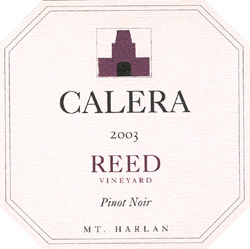 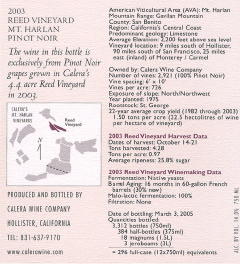
* Note about Dick Graff at Chalone. An article appeared in Connoisseur (February, 1987) written by Eunice Fried that notes that Chalone’s site was chosen for its soil which is volcanically underlain with limestone and calcium carbonate, very similar to the soil of Burgundy. Graff notes, “Chardonnay and Pinot Noir is greatly influenced by the soil they’re planted in, especially Pinot Noir. Because it’s so delicate, it takes a great deal of its character from the soil. In California, where millions of years ago the Pacific plate began sliding under the Continental plate, catching marine deposits between, the limestone deposits are highly irregular. In Europe, limestone is laid down in rather even strata. I can find no reference in the literature nor have I seen any comments from Jensen that he was influenced by Graff, but certainly he must have been aware of the precedent set by Graff in the same mountains that he himself decided to set roots down on. Graff was one of the first people in California to use French oak barrels (1965) and bottles made in France from a special Burgundian mold. He stored his barrels in caves dug into the mountainside at Chalone. A fan of whole cluster fermentation, Graff believed that this process supplied the extra tannin that he preferred in his Pinot Noirs. Like Jensen, he was a man of great foresight and innovation.
george wine company, vintage IVRegular readers of the PinotFile will know the story of george wine company. George Levkoff had his wine epiphany when a friend brought a 1991 and 1992 Williams Selyem Rochioli Vineyard Pinot Noir to share at dinner. Four years later, he left his job as a bond trader on Wall Street and headed west to Sonoma. He interned at Williams Selyem from 1999 to 2002, learning the winemaking process. He also worked at the smaller Brogan Cellars which was more closely modeled after the type of winery he hoped to have for himself. With grapes from David Hirsch of Sonoma Coast’s Hirsch Vineyard, he released 150 cases of his inaugural Pinot Noirs in 2003 (Block 3A from the Pommard clone and Block 4A from the Mt. Eden clone). The wines immediately caught the attention of top sommeliers at restaurants in Las Vegas and New York and his Pinot Noir has become quite a cult wine. I have been a fan from the beginning, entranced by the elegance and sensuality that his wines exhibit.
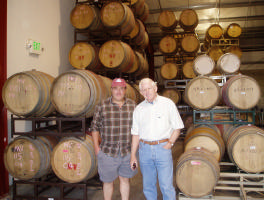 Vintage II (2004) consisted of 125 cases of Hirsch Block 3A and Block 4A Pinot Noir and 125 cases of Martinelli Nuptial Vineyard Russian River Valley Pinot Noir. Vintage III (2005) yields were minuscule at Hirsch and george only made tiny amounts of Hirsch Pinot Noir along with the Martinelli Nuptial Vineyard Pinot Noir. The Vintage IV (2006) offering has just come out. With this latest vintage, george has achieved his initial goal of producing 500 cases of Pinot Noir. The releases include the 2006 george Martinelli Nuptial Vineyard Russian River Valley Pinot Noir (300 cases), 2006 george Leras Family Vineyard Russian River Valley Pinot Noir (100 cases - farmed by Nick Leras since 1957) and 2006 george Marta Ella Vineyard Russian River Valley Pinot Noir (100 cases - this vineyard is adjacent to, and owned by Benovia Winery and is managed by well-respected viticulturist Daniel Roberts). The three Pinot Noirs are sold in either a 6-pack ($300)or 12-pack ($600) mixture of the three wines. Now george has a thing for small case, but his wines are good with a capital G. He is a one-man show and his wines show his imprint from start to finish. He sorts the grapes by hand, does the punch-downs, crafts the wine (100% new Francois Freres French oak), bottles the wine, hand-numbers each bottle, and personally delivers the wine to many customers. I have not tasted the 2006 Pinot Noirs, but here is a recent tasting note from last year’s vintage.
2005 george wine company Vintage III Nuptial Vineyard Russian River Valley Pinot Noir 13.9% alc., 322 cases, $50. · I went ga-ga over this one. Terrific and alluring aromas of Bing cherry, sandalwood, root beer and toast. Juicy flavors of cherry cola, mocha and spice including cinnamon and sassafras. Although light in color and body, it packs a wallop. Elegant, feminine and balanced beautifully. Pinot Noir all decked out in its finest lingerie. You’ll need a cold shower after drinking this one.
george wine company is located in Healdsburg (the wine is made at Moshin on Westside Road in the Russian River Valley). The wines are sold exclusively to a mailing list at www.georgewine.com. 707- 495-7783. If you can’t snag some, the following restaurants have it: Aureole Restaurant, Charlie Palmer Steak, Delmonico Steakhouse, Le Cirque, Michael Mina Bellagio, Postrio, Spago all in Las Vegas, BLT Steak, Buddakan, Café Boulud, Gotham Bar & Grill, craft, db Bistro moderne, Eleven Madison Park all in New York City, and Campanile, CUT, Cyrus, Dry Creek Kitchen, Jardinere, Madrona Manor, Restaurant Gary Danko, and XYZ, all in California.
Hanzell Celebrates 50th AnniversaryHanzell is California’s first ‘boutique’ wine estate. Diplomat James D. Zellerbach and his wife, Hana, became fond of Burgundy and its wines while he served as an American ambassador to Italy. Zellerbach was president of Crown Zellerbach, a large forest products company at the time. The Zellerbachs were so inspired that they purchased land on Sonoma Mountain above the town of Sonoma and set to building a winery of redwood and local stone fashioned after Burgundy’s Clos de Vougeot. They planted their first vines in 1953: Chardonnay using the Wente clone and Pinot Noir using the Martin Ray clone. The Martin Ray clonal material was reputedly from a clandestine late night raid on a Napa Valley vineyard by Hanzell’s initial winemaker, Brad Webb. Over the years, the vines have mutated and new vines propagated from them creating a distinct Hanzell selection. Winemaking at Hanzell was very Burgundian from the beginning and Zellerbach was among the first in California to utilize French oak barrels. In addition, Zellerbach designed the first temperaturecontrolled stainless-steel fermentation tanks used in conjunction with the traditional French oak barrels. He was also was the first to use nitrogen in bottling. Small amounts of wine were sold starting in 1957, but 1965 was the first full-scale commercial vintage. Bob Sessions followed Brad Webb and was the general manager and winemaker at Hanzell for 33 years. He retired in 2005 and was replaced by Michael Terrien. Today, Hanzell’s vineyards have increased to 42 acres (27.5 acres of Chardonnay and 14.5 acres of Pinot Noir) which produce 3,000 cases of wine. The current owner is Alexander de Brye. The Chardonnays have been the star at this winery and often hold up beautifully to and beyond 20 years. The Pinot Noirs have had their advocates as well. In 2003, an elevated level of the chemical TCA (2,4,6-trichloroanisole) was found at Hanzell in the winery itself. Sales of the wines were stopped (the 2000 Chardonnay and 1999 Pinot Noir were eventually sold to interested consumers since the amounts of detectable TCA were extremely minute) and the original winery was abandoned. A new winery was constructed and a cave system excavated for cellaring wine. James Laube of the Wine Spectator brought the TCA problem to Hanzell’s attention. Hanzell’s TCA problem was minute - 2 parts per trillion in the Chardonnay and 3 parts per trillion in the Pinot Noir (equal to two or three grains of salt in a swimming pool!). The wines from the 2003 vintage on have been clear of TCA. The original Hanzell Pinot Noir vines planted in 1953 by Zellerbach are claimed by Hanzell to be the oldest Pinot Noir vines in California. The vines at Mt. Eden were the oldest producers until they were pulled out in 1997. John Haeger has spoken in recent years of a 1946 block of Pinot Noir at Chalone but it is unclear to me whether these vines are still producing. Regardless, the vines at Hanzell were fifty years old in 2003. To commemorate the 50th anniversary, Hanzell selected five barrels of a single vineyard bottling. A total of 110 cases were produced ($160). Like all Hanzell wines, the special bottling is highly allocated to wine club (Ambassador Circle) members. The 2004 Estate Pinot Noir (1,400 cases, $90) is the current regular release. The label on Hanzell wines (pictured right) has never changed.
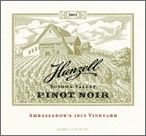 1997 Hanzell Vineyards Sonoma Valley Pinot Noir 14.5% alc.. · Gorgeous garnet color. Noteworthy heat on the nose and finish. Heady cherry fruit flavors. Soft in texture with fine-grained tannins persisting. Admirable for a ten-year-old California Pinot Noir but rather one-dimensional.
Hanzell Vineyards is located at 18596 Lomita Ave, Sonoma. Tours and tastings are by appointment (707-996-3860). The website is www.hanzell.com.
Sustainability at the Heart of Cork SupportThe first reference to cork dates to 3000 B.C., in China, where it was used as part of fishing equipment. Cork was first used as a stopper for wines in 1670 by the French abbott Dom Perignon for the sparkling wine of his Hautvilliers’ monastery (prior to this, wine was closed with wooden bungs wrapped in hemp). Cork is made from the bark of the cork oak tree and no trees are cut down for cork production. The average lifespan of a cork oak varies between 170 and 200 years. This means the tree can regenerate cork suitable for wine closure about 17 times in its life. Each time a cork tree is harvested, the cork bark regenerates itself. The world’s supply of cork is not dwindling as there is about 4% growth from natural regeneration and plantings. The photo below is a cork tree in South West France (Tony Boon). 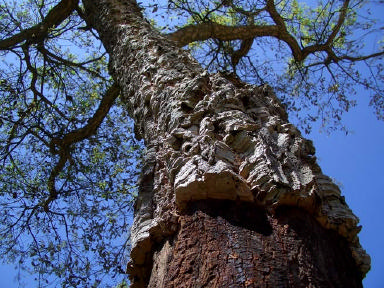 The cork industry has spent millions of dollars over the past 10 years to ensure cork quality has improved. Carbon dioxide washed and steam washed corks have either eliminated TCA or reduced TCA below threshold levels. A French cork supplier claims to have eliminated TCA taint entirely and another one in Portugal has reduced TCA taint to under 1%. Paul White, writing for the Slow Food movement, summarizes the value of cork. “For more than two centuries, winemaking, wine maturation and, indeed, wine styles have been closely allied to the mechanical and chemical properties of cork. Indeed, without cork humanity would never have defined the concept of terroir. Where a few years ago cork looked like it was staggering along on its last legs, it now seems to have picked itself up by the bootstraps, dusted off its nastiest habits, and seems to be facing a relatively bright future. And from a Slow Food perspective, that’s a good thing.”
Pinot BriefsMendo Wine The Mendocino Winegrowers Association presents Mendocino Wine by the Bay on September 15, from 12-5 PM at the Embarcadero Hyatt Regency in San Francisco. 45 wineries, 200 wines, and food from some of San Francisco’s best restaurants. Proceeds will benefit Friends of the Children San Francisco and CUESA. Tickets are $35 in advance, $45 at the door. Information - 707- 468-9886. TCA The Los Angeles Times reported a few months ago a technique for rescuing wines tainted by TCA. Take a square-foot of Saran Wrap, wad it up, and stuff it into a large glass pitcher. Pour the wine over the wrap into the pitcher, swirl it around for 10 minutes. The polyethylene in the Saran Wrap will absorb the TCA and supposedly return the wine to its more natural and palatable condition. 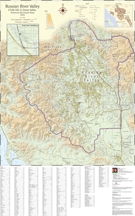 Pinot Country Maps The Map Store in Windsor, California has published seven maps of the AVAs of Sonoma County under the direction of the Sonoma County Winegrape Commission. These poster-sized maps are very detailed and show the location of Sonoma’s towns, wineries and even vineyards. I recently purchased the Russian River Valley AVA map (which includes Chalk Hill and Green Valley). I had always wanted a map showing the specific locations of the vineyards that are referenced in the wine literature and displayed prominently on wine labels. I had mine mounted on poster board and the total came to about $85 ($30 for the map only). The Map Store website (www.TheMapStore.com) will be launching a free WineMap service on the website supplying detailed information on wineries in the near future. Wine Beer This new product from small breweries is brewed like beer but made with fruity tastes and aromas like wine, barrel aged, and usually with alcohol levels between 10% and 15%. Russian River Brewing produces Supplication, a brown ale aged for a year in Pinot Noir oak barrels with sour cherries. Delaware’s Dogfish Head Craft Brewery has a wine beer called Red & White which is brewed with orange peel and Pinot Noir juice. The wine beers are intended to be drunk warmer than beer. Reconditioned Burgundy John Kapon (Acker Merrill Condit) writing in Vintage Tastings points out that wines from Domaine Romanee-Conti could be reconditioned at the winery up until 1996. Aubert de Villiene regrets doing this because he found that although reconditioned wines can be great, they never achieve the heights of a well-stored original bottling. These reconditioned “Direct from the Chateau” bottles sometimes demand even more on the secondary market because of their ‘provenance’, yet most of them are less complex wines because they have been reconditioned. One note: curiously, Domaine Romanee-Conti does not have a website. Offspring of Pinot Noir The University of Minnesota grape breeding program has released a hardy descendent of Pinot Noir, Marquette, which is able to withstand temperatures as low as minus 36°F. As reported in Wines & Vines (May 2007), the release comes at an opportune time for there is increasing interest in viticulture and wine country tourism in colder Northern America regions such as Vermont, Missouri, Iowa, Colorado and North and South Dakota. It is expected to gradually replace Frontenac which can withstand temperatures as low as minus 33°F, but is high in acid, low in tannin and produces a respectable red wine at best.
Devil’s Gulch Ranch CampMany of you plan to visit Northern California Wine Country in the future. Why not treat your kids to a great time as well and drop them off at Devil’s Gulch Ranch Camp in Marin County. At this working diversified family farm (including Devil’s Gulch Vineyard), children can learn about vineyards and gardens, pigs, sheep, chickens, horses and rabbits. Activities include tying flies and jewelry, spinning and ceramics, blacksmithing and welding, repelling and hiking, archery and swimming. The camp staff is mostly young women whose background has been thoroughly checked by police. The executive director has a masters in Ag education with numerous teaching positions and camps in his resume. Sessions are available by the day, weekend or week. For more information phone 415-662-1099 or visit the website at www.devilsgulchranch.com.
Pinot Noir Genome SequencedFrench and Italian workers, part of the Public Consortium for Grapevine Genome Characterization, have published the complete genome sequence of Vitis vinifera using an inbred Pinot Noir strain. The Pinot Noir cultivate used is not the same as you will find in a bottle, but is inbred or simplified to lose replicated genes and achieve high homozygosity so the sequence could be pieced together. The grapevine’s DNA was found to contain 30,434 genes that carry instructions to make the vine. The researchers found that compared to other flowering plants, grapevines have twice as many genes linked to production of enzymes associated with aromas. Terpene synthases (TPSs) are responsible for the tannins and oils that create aromas in the grapevine. The other three plants that have been sequenced have between 30 and 40 genes to makes these syntheses; the grapevine has 89 functional TPS genes and 27 pseudogenes. 13 distinct genes were found responsible for Pinot Noir’s distinctive flavors. This would indicate that the variety of aromas and flavors found in wines are closely allied with the genomics of the grapevine. Grapevines also have more of the genes that produce resveratrol, the antioxidant in red wine associated with the health benefits of moderate consumption of red wine. Stilbene synthase enzymes (STSs), responsible for the synthesis of resveratrol, were represented by a hugely inflated number of genes (43 STS genes, of which at least 20 are active). The information may lead to several practical applications. Vintners may be able to trace specific aromas and flavors to certain genes and add or subtract important characteristics to their final wines. In addition, this research may lead to the development of grapevine cultivars that are resistant to diseases that commonly afflict grapevines such as mildew, fungus and other pests. The full report will be published in Nature in a few weeks. The online published letter is at www.nature.com. |